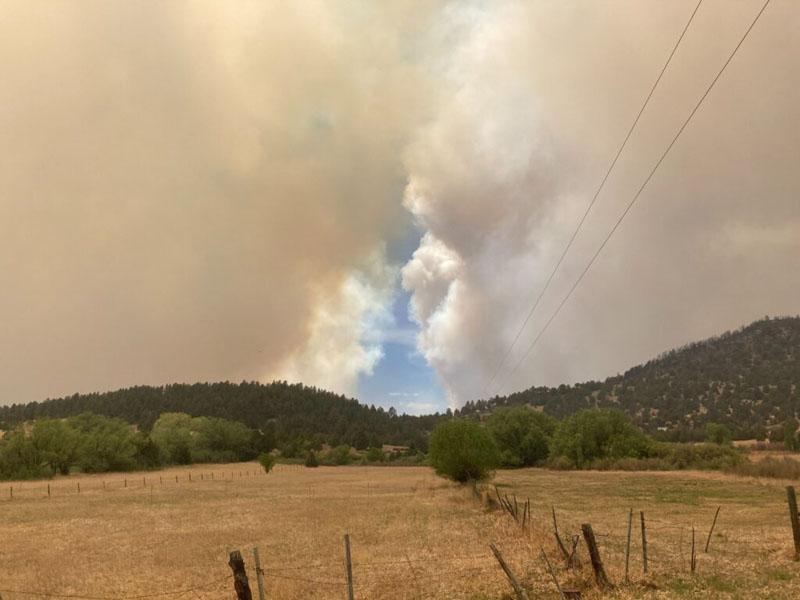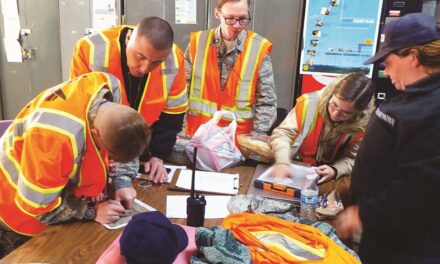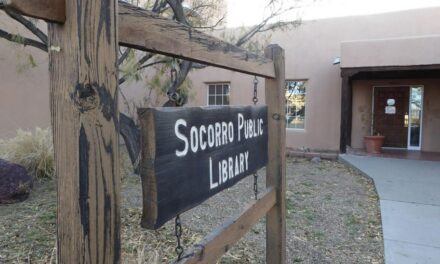
Smoke from the Hermits Peak-Calf Canyon fire is visible from Mora, N.M. on May 22, 2022. (Photo courtesy Santa Fe National Forest)
As the United States Forest Service conducts a review of its prescribed burn protocol over the next several months, Gov. Michelle Lujan Grisham’s office is calling for several big changes to the way federal agencies determine whether a burn is a good idea.
The changes the governor seeks are generally aimed at ensuring federal agencies are adapting to realities of climate change, according to a spokesperson.
“The governor stressed that what used to be extreme is now much more common,” spokesperson Nora Sackett said in an email Friday, “which I understand the Forest Service was very receptive to.”
What became the Hermits Peak fire started as Las Dispensas prescribed burn about 12 miles north of Las Vegas in early April. The burn was carried out of containment lines due to “unexpected erratic winds” and then joined forces with the Calf Canyon fire a couple weeks later. The combined fire is now the biggest in state history.
The governor and members of the state Congressional delegation have criticized Santa Fe National Forest officials for igniting the burn, particularly on a windy April day during a severe drought. They say the federal government is liable for the damage the blaze has since caused, including the displacement of thousands of people and destruction of hundreds of homes.
Late last week, Lujan Grisham spoke with Randy Moore, chief of the United States Forest Service, and other federal officials after the blaze. Shortly afterward, Moore announced a 90-day “pause” on the burns, citing high fire risk and a review of agency protocols around controlled burns.
This week, her office released more details about requests the governor made of the Forest Service in response to an inquiry from Source New Mexico.
For one, Lujan Grisham said the state would like more consultation with local officials ahead of prescribed burns “to incorporate their deep knowledge of the terrain and weather patterns.” The Forest Service did not consult New Mexico State Forestry officials or San Miguel County, where the burn took place, ahead of the prescribed burn, the agencies previously told Source New Mexico.
As of Tuesday, May 24, at 8 a.m.
The Hermits Peak-Calf Canyon wildfire had grown to 311, 148 acres.
It was 41% contained.
In addition, the governor, citing climate change, said burn bosses need to add more variables to their calculation about whether a burn is safe, and they need to re-evaluate their rules more often to make sure they’re adapting to the realities of a hotter, drier climate.
Specifically, the Forest Service should add the “vapor pressure deficit” to its models, Lujan Grisham is suggesting. That measure, which is an alternative to relative humidity, allows burn bosses to evaluate how much moisture is in plants, soils and fire fuels. A study from 2014 determined that the variable was a better predictor of damage after wildfires than drought, temperature or precipitation.
The Forest Service currently looks at relative humidity, which was predicted to be between 9% and 13% on April 6, the day of the burn, according to spot forecasts the fire crew reviewed before ignition.
The governor’s office is also hoping federal burn bosses will heed the “Hot-Dry-Windy Index” more closely. That index, which the Forest Service first announced as a new tool in 2018, seeks to help forest managers better determine whether it’s safe to ignite a burn.
It’s not clear whether the burn boss would have looked at that or any other indicator before the burn, though the service has said that conditions were within the parameters they use to determine a burn is safe. The service has refused to provide a copy of its burn plan to Source New Mexico, saying it would be “premature” as the agency conducts a review of its decision-making that day.
The governor’s office is also asking the Forest Service to assume that spot fires will occur 1-2 miles away from the burn site and evaluate fuel conditions in that area. Unprecedented high winds have carried embers more than a mile in recent weeks, officials have said, which has made fighting the megafires here even more dangerous and complicated.
Finally, the governor’s office is asking the federal forest management agencies to improve their wind modeling ahead of burns. The spot forecast on April 6 showed wind gusts up to 25 mph.
Taken together, the governor’s office said the Forest Service needs to adapt to the realities of climate change on a rolling basis and change their rules accordingly to account for hotter, drier, windier conditions that could allow a prescribed burn to escape.
“Models and protocols should be reviewed on an annual basis,” Maddy Hayden, a spokesperson for the Governor’s Office, said in an email Monday, “because climate change is happening faster than many expected and we need to assume even a one-year-old model is outdated.”
Story from Source NM
















